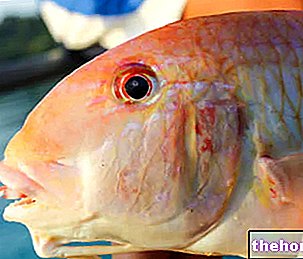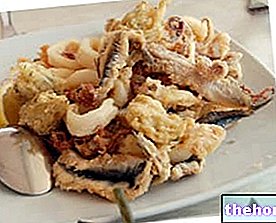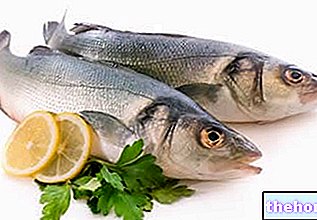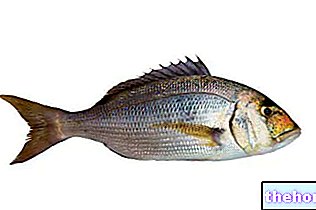What is sushi?
Sushi is a Japanese dish based on rice, fish, seaweed, vegetables and eggs; the term "sushi" indicates innumerable rice-based preparations but, outside its place of origin,

Sushi is made from raw, cooked or marinated products, it can be tied with a strip of seaweed, rolled in rice or paired with tofu; it is a wide range of preparations that differ both in ingredients and in the preparation technique and toppings present in the dish. The most common sushi varieties are:
makizushi (rolled fish), oshizushi (pressed sushi), nigirizushi (hand-molded sushi), inarizushi (stuffed sushi), chirashizushi (scattered sushi), narezushi, funazushi... plus all the relative sub-variants of each of them.
Nutritional characteristics
Quantifying the nutritional characteristics of sushi is not an easy "undertaking; as can be deduced from the previous paragraph, sushi represents hundreds of different combinations, therefore, describing them individually would be a" painstaking and quite meaningless "undertaking.
Instead we will try to illustrate a sufficiently exhaustive picture of the main ingredients that (more frequently in Italy) go to make up sushi:
- White rice (sushi-meshi): it is a variety of short grain rice prepared according to a particular process with the addition of sake (rice distillate), kombu, sugar and salt; the nutritional characteristics remain more or less the same as any white rice, therefore, sushi-meshi is characterized by a high energy intake deriving mainly from complex carbohydrates. There is not enough information to provide a more detailed picture but, logically, this carbohydrate source (given the association with other more protein foods) should boast a moderate glycemic index.
- Seaweed (nori): it is a "seaweed grown and harvested in Japan; it undergoes a process of scraping, pressing and drying, to be subsequently toasted and packaged. Nori is a food that has been discussed a lot in recent years; it is an important" protein source (with prevalence of the amino acid arginine), vitamins (vit. C, vit. A, vit. PP and folic acid) and iodine (I). However, given its use in our country (even considering the regular intake with sushi), the relative nutritional contribution is almost nil. The carbohydrate content is moderate.
- Omelette (tamagoyaki): in some preparations a "square" omelette is used instead of nori; the nutritional contribution is that of the whole egg, therefore it is characterized by a fair amount of protein, a considerable percentage of saturated fats and cholesterol, good amounts of iron, sulfur, vitamin A, biotin, vit. D, vit. E, vit. B2 and vit B12. The carbohydrate content is absent or negligible.
- Raw fish (fish products): in our country, the raw fish most used for the preparation of sushi are: sea bream, sea bass, tuna, salmon, shrimp, cuttlefish, cooked octopus (sometimes bonito and mackerel or lanzardo). These are ingredients that on average are united by a moderate energy intake and good protein quantities, a reduced lipid content (except for the tuna belly ... but used RARELY) and (theoretically) characterized by a fair percentage of polyunsaturated fats . Vitamins and minerals vary according to the species, but it is possible to say that the most significantly present elements are some vitamins of the B complex and vitamin D; the contributions of vitamin B12 and iodine are also worthy of note. carbohydrate is absent or negligible.
- Vegetables, fruits and vegetables: mainly horseradish, avocado, cucumbers, plums and a few others. The quantities are quite small and the predominant nutritional contribution is represented by the fiber (however insufficient to reach the rations). The avocado is a highly caloric fruit due to the significant contribution of fat, but even in this case its contribution is not sufficient to significantly affect the nutritional balance of the dish (with the due differences referring to the preparations that contain more than the average ).
- Red meat: it is present in portions similar to those of fish, therefore reduced. Like the latter, it provides a good quantity of proteins and saturated fats, some vitamins of the B complex and more cholesterol than fish products; noteworthy is the contribution of vitamins. B12 and that of iron. The carbohydrate content is absent or negligible.
- Tofu: is a product commonly called soy cheese; in fact, it is practically made from soy milk which, being a legume derivative, boasts characteristics that are anything but comparable to those of cheeses derived from animal milk. Tofu is extremely low in calories compared to common dairy products. a good protein ration accompanied by an "equally good lipid quantity, consisting mainly of unsaturated fats but absolutely cholesterol-free, on the contrary rich in lecithin (phospholipid with hypocholesterolemic action). The intake of carbohydrates is modest but still present. It provides good amounts of calcium, potassium and iron; the vitamin intake is discreet as regards: vit. B1, vit. B2 and vit. PP.
- Toppings: generally consist of soy sauce, green horseradish paste (wasabi), pickled ginger (gari), shiso and sweet rice wine (mirin). They have no particular nutritional characteristics to report (given the typical portions of use of condiments) if not the high sodium content contained in the soy sauce.
Sushi represents a group of macronutritional distribution preparations mainly characterized by carbohydrates, as rice is always present in good quantities; There are also proteins with a high biological value deriving from meat, fish and eggs, and mixed quality lipids, both saturated and unsaturated, with a notable supply of essential fatty acids. The vitamin quantity is good but NOT complete, especially the vitamin is missing. C, while the mineral one seems quite heterogeneous even if, with these portions of meat, fish, eggs and tofu, reaching the recommended levels of calcium and iron is not an easy task. The only noteworthy detail is the lack of dietary fiber and in particular of soluble fiber.
There are no limitations in the frequency of consumption of sushi but there are recommendations; it is advisable to integrate the sushi-based diet with fresh fruit and vegetables but above all .... pay attention to raw materials potentially at risk of fish parasites (see dedicated article: raw fish - risks and benefits of raw fish).
Sushi Special - Video Recipes
- Sushi - Ingredients, Necessary Tools and Recipes
- How to Cook Sushi Rice
- Tamagoyaki omelette
- Hosomaki Sushi
- Nigiri Sushi
- Futomaki Sushi
- Uramaki Sushi or California Roll
- Gunkan Maki Sushi
- Temaki Sushi
- Vegan Sushi
- Fruit Sushi
What is Sushi and How to Prepare Rice
Problems with playing the video? Reload the video from youtube.
- Go to the Video Page
- Go to the Video Recipes Section
- Watch the video on youtube
Fish, Molluscs, Crustaceans Anchovies or Anchovies Garfish Alaccia Eel Lobster Herring Lobster Whitebait Bottarga Sea bass (Sea bass) Squid Canocchie Scallops Canestrelli (Sea scallops) Capitone Caviar Mullet Monkfish (Monkfish) Mussels Crustaceans Dates Sea Fruits Fish Flour Fauna Fish stock Prawns Crabs Spider crab (Granceola) Halibut Sea salad Lanzardo Leccia Sea snails Prawns Cod Molluscs Octopus Hake Ombrina Oysters Sea bream Bonito Pangasius Paranza Anchovy paste Fresh seasonal fish Blue fish Puffer fish Swordfish Plaice Octopus (Octopus) Hedgehog of Sea Amberjack Salmon Sardines Sardines Scampi Cuttlefish Mackerel Sole Stockfish Surimi Sushi Telline Tuna Canned tuna Mullet Trout Fish roe Bluefish Clams OTHER FISH ARTICLES Categories Alcoholic Food Meat Cereals and derivatives Sweeteners Sweets Offal Fruit Dried fruit Milk and derivatives Legumes Oils and fats Fish andpeach products Salami Spices Vegetables Health recipes Appetizers Bread, Pizza and Brioche First courses Second courses Vegetables and Salads Sweets and Desserts Ice creams and sorbets Syrups, liqueurs and grappa Basic preparations ---- In the kitchen with leftovers Carnival recipes Christmas Light diet recipes Women's, mom's and dad's day recipes Functional recipes International recipes Easter recipes Celiac recipes Diabetic recipes Holiday recipes Valentine's Day recipes Vegetarian recipes Protein recipes Regional recipes Vegan recipes




























